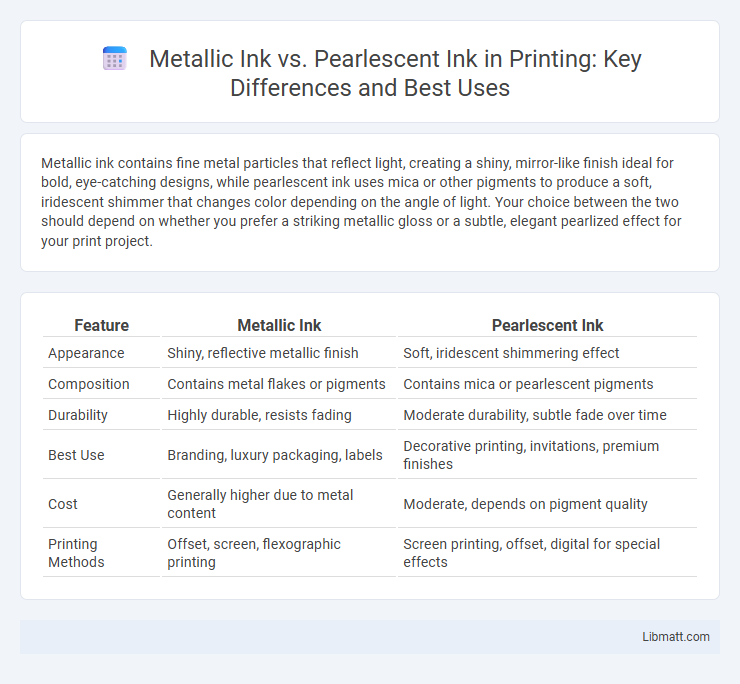Metallic ink contains fine metal particles that reflect light, creating a shiny, mirror-like finish ideal for bold, eye-catching designs, while pearlescent ink uses mica or other pigments to produce a soft, iridescent shimmer that changes color depending on the angle of light. Your choice between the two should depend on whether you prefer a striking metallic gloss or a subtle, elegant pearlized effect for your print project.
Table of Comparison
| Feature | Metallic Ink | Pearlescent Ink |
|---|---|---|
| Appearance | Shiny, reflective metallic finish | Soft, iridescent shimmering effect |
| Composition | Contains metal flakes or pigments | Contains mica or pearlescent pigments |
| Durability | Highly durable, resists fading | Moderate durability, subtle fade over time |
| Best Use | Branding, luxury packaging, labels | Decorative printing, invitations, premium finishes |
| Cost | Generally higher due to metal content | Moderate, depends on pigment quality |
| Printing Methods | Offset, screen, flexographic printing | Screen printing, offset, digital for special effects |
Introduction to Metallic and Pearlescent Inks
Metallic inks contain fine metallic particles or mica that reflect light, creating a shiny, mirror-like finish ideal for eye-catching labels and packaging. Pearlescent inks incorporate mica or pearlescent pigments that produce a soft, iridescent shimmer with color-shifting effects, enhancing elegance and depth in printed materials. Both inks are widely used in high-end branding to add visual impact and luxury appeal.
Defining Metallic Ink
Metallic ink contains fine metal particles that reflect light, creating a shiny, mirror-like finish ideal for high-impact branding and packaging. Its composition includes aluminum or bronze powders suspended in a binder, offering durability and a striking metallic luster. Unlike pearlescent ink, which produces a soft, iridescent shimmer using mica-based pigments, metallic ink provides a bold, reflective surface that enhances visibility and elegance.
Defining Pearlescent Ink
Pearlescent ink contains mica or pearlescent pigments that create a subtle, shimmering effect with a soft, iridescent glow, differentiating it from metallic ink's reflective, mirror-like finish. Your choice between pearlescent and metallic ink depends on the desired visual impact; pearlescent ink offers a more elegant, understated luster while metallic ink provides a bold, shiny appearance. This unique sheen makes pearlescent ink ideal for luxury packaging, greeting cards, and high-end print materials seeking a sophisticated look.
Key Differences Between Metallic and Pearlescent Inks
Metallic ink contains fine metal particles that create a reflective, shiny finish, ideal for bold, eye-catching designs, while pearlescent ink uses mica or synthetic pearls to produce a soft, iridescent shimmer with subtle color shifts. Your choice depends on the desired visual impact: metallic inks offer a more intense, mirror-like gleam, whereas pearlescent inks provide elegant, luminous effects with a gentle glow. Both inks enhance printed materials but serve different aesthetic purposes based on their unique light-reflecting properties.
Visual Effects and Finish Comparison
Metallic ink delivers a reflective, mirror-like finish with high shine that enhances contrast and creates a bold, eye-catching effect ideal for luxury packaging and branding. Pearlescent ink offers a subtle, iridescent shimmer with soft color shifts under different lighting, producing a sophisticated, elegant finish suitable for invitations and cosmetic packaging. Both inks provide unique visual textures, but metallic ink emphasizes vivid brilliance while pearlescent ink highlights delicate luminosity.
Composition and Ingredients
Metallic ink contains metal flakes, usually aluminum or bronze, suspended in a binder to create a reflective, shiny finish. Pearlescent ink, on the other hand, uses mica or titanium dioxide pigments that refract light to produce an iridescent, pearl-like effect. Both inks rely on specialized additives for adhesion and durability but differ significantly in their optical properties due to their distinct compositions.
Applications in Printing and Design
Metallic ink enhances printing and design by adding reflective, shimmering effects ideal for luxury packaging, labels, and promotional materials. Pearlescent ink offers a subtle, iridescent finish that changes color based on light angle, making it popular for high-end invitations, cosmetics packaging, and artistic prints. Both inks elevate visual appeal but are chosen based on desired effect--metallic for bold shine, pearlescent for elegant, color-shifting brilliance.
Durability and Longevity
Metallic ink offers superior durability with its resistance to fading, scratching, and environmental factors, making it ideal for long-lasting applications. Pearlescent ink, while visually stunning with its shimmer and depth, tends to be less resilient under harsh conditions, potentially showing signs of wear over time. Your choice depends on whether longevity or aesthetic appeal is the priority for your project.
Cost Considerations
Metallic ink generally offers a more budget-friendly option compared to pearlescent ink, making it ideal for projects with tight cost constraints. Pearlescent ink involves complex formulations and additives that increase production expenses, resulting in higher pricing. You should evaluate your design's visual impact against budget limits to choose the most cost-effective ink type.
Choosing the Right Ink for Your Project
Metallic ink offers a reflective sheen with vibrant gold, silver, and bronze tones ideal for bold, eye-catching designs, while pearlescent ink provides a subtle shimmer with a softer, multi-dimensional finish that changes with light angles, suitable for elegant and sophisticated prints. Selecting the right ink depends on the desired visual impact, substrate compatibility, and print method, as metallic inks often require UV curing and pearlescent inks perform well on coated papers. Budget considerations and the project's purpose also influence the choice, where metallic ink suits promotional materials and packaging, and pearlescent ink enhances high-end invitations and luxury branding.
metallic ink vs pearlescent ink Infographic

 libmatt.com
libmatt.com